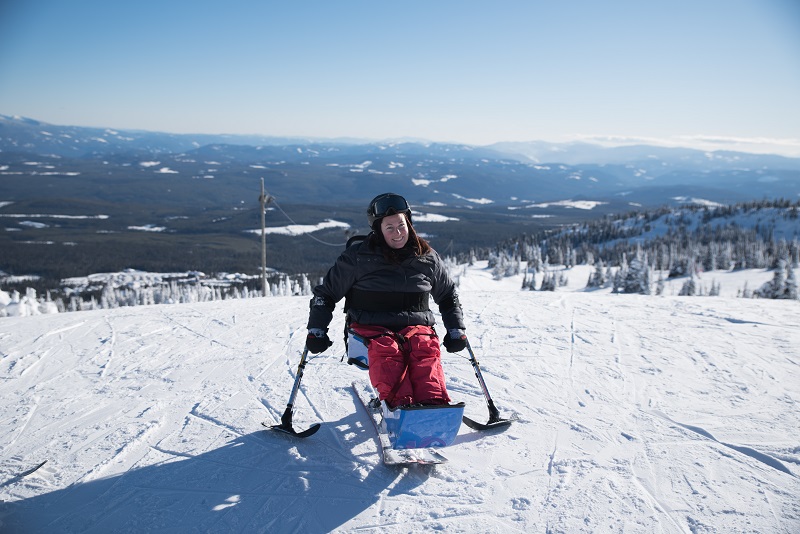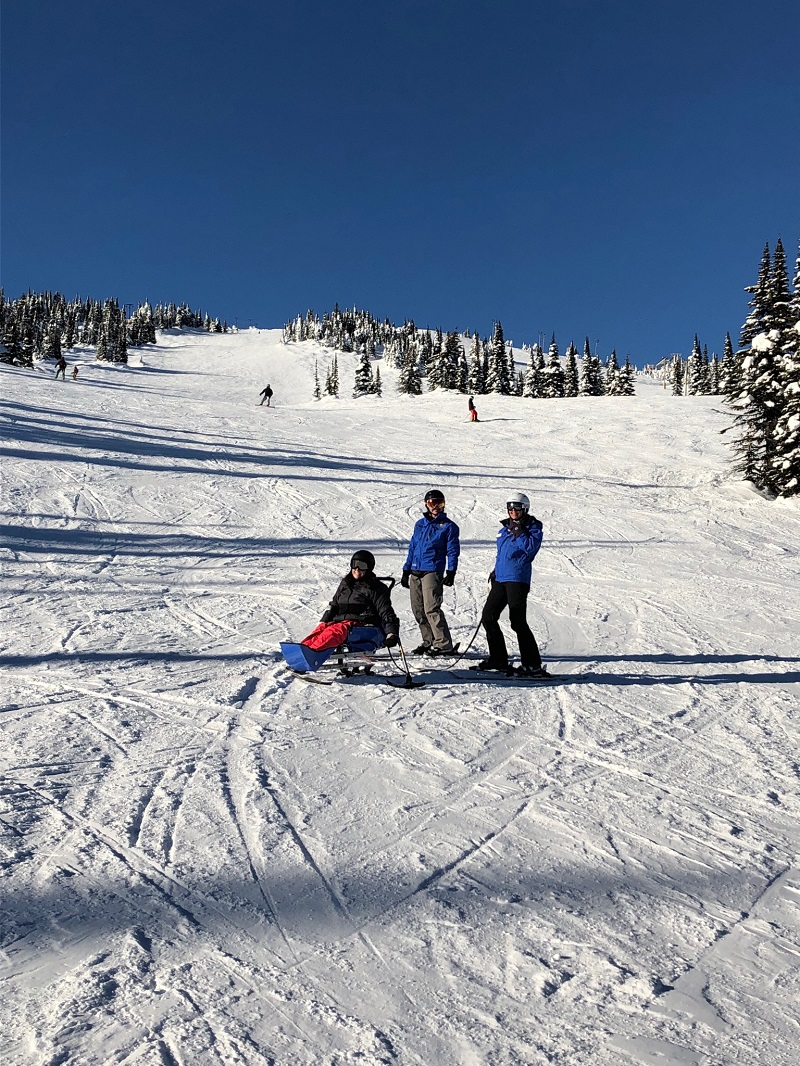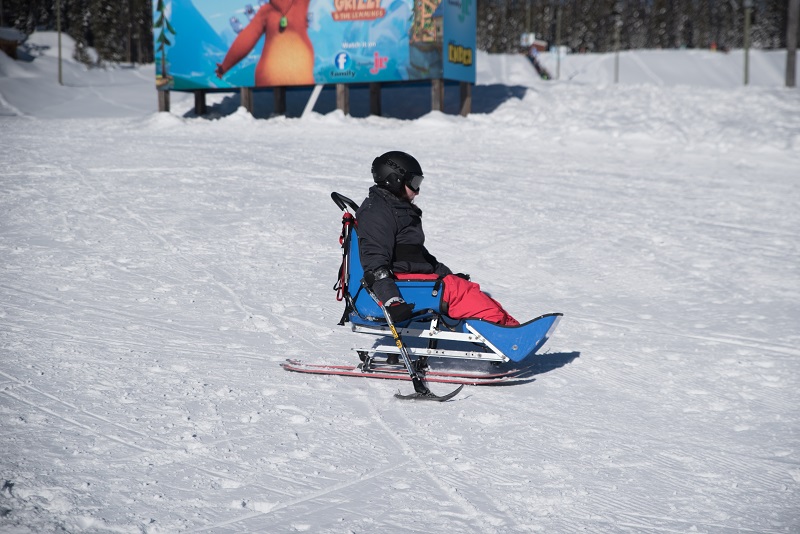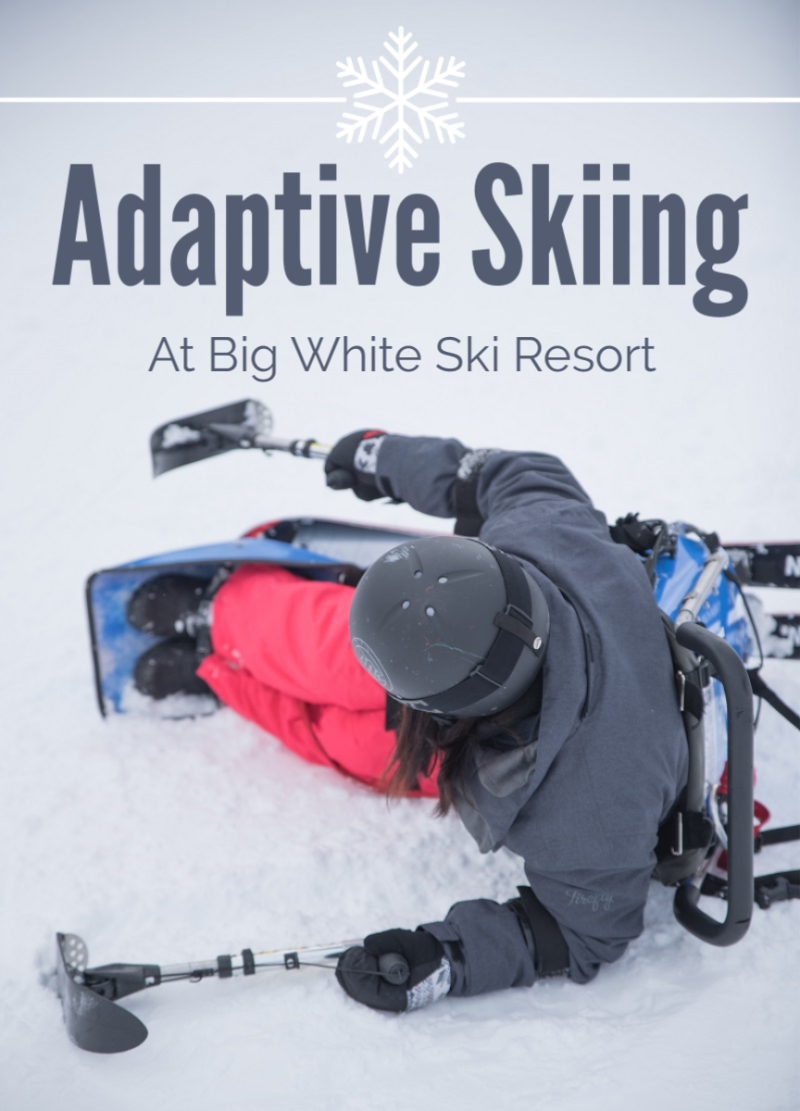About a year ago, a friend told me I should try adaptive skiing. I laughed.
But this past weekend—because my FOMO is greater than my fear of skiing—that is precisely what I did.
And at the top of the first little hill, strapped into a sit-ski with mixed emotions of excitement and terror, I felt like I lost a bet, but I wasn’t even mad about it.

Big White Adaptive Skiing – At the top of the hill – Photo Codi Darnell
When my husband and I were invited on a couple’s getaway to Big White Ski Resort, I never thought I would get out on the mountain. I always thought sit-skiing was one of those adapted sports that only really strong, Paralympian type athletes could do. But my curiosity got the better of me – and because I didn’t want to sit in the condo the entire weekend – I did a quick search that introduced me to the adapted ski program at Big White.
As it turns out, you can teach your average paraplegic like me to sit-ski. Big White’s adaptive program is run by Powderhounds Adaptive Snowsports and BC Adaptive Snowsports, and whether you want to learn to ski the slopes on your own or just go for a fantastic ride down the mountain with the instructors, they can make it happen. Their team of certified volunteer instructors are there to help people of all ages with different physical, cognitive or sensory challenges, get out and explore the beauty of Big White.

With Instructors on the way down – Photo Codi Darnell
Each instructor I worked with filled me with confidence, and they all seemed genuinely excited to help me get on the mountain. They pulled me up small hills, gave different ideas when something wasn’t making sense, helped pick me up when I fell over and took me for a couple of amazing rides down the larger, steeper sections of the mountain. If you have ever wanted to feel what it’s like to ski down a mountain but didn’t think you could, this program is for you. Even if you are stubbornly independent (like me) and you are sceptical of being taken for a ride down the mountain, I would urge you to reconsider—it was a blast.
The mountain itself was beautiful. Big White’s beginner learning area is perfect for both kids and adults just starting and I love the fact you can pay for a discounted beginner day pass if you are only going to use the learning area and the Plaza Chair. Our entire group was impressed with the mountain and its 15 lifts and 119 runs—the diverse terrain kept everyone happy. The rental shop was fast and efficient and got everyone up on the hill with the right gear.
Tip: Residents of British Columbia and Alberta can save on lift tickets by purchasing a Biggie Card at select locations across the two provinces.
While there are some logistical issues of visiting a snowy mountain in a wheelchair, the team of instructors were happy to troubleshoot the best way to get me to the sit-ski. And when we woke up our first morning to fresh snow and sunshine, I was thrilled to be able to get outside and be a part of the experience instead of watching everyone else enjoy it. Being in a sit-ski not only allowed me to get out on the mountain with my husband again, but it gave me the freedom to explore places I never could while in my wheelchair. And it renewed my faith that skiing is something we could still do as a family. Next year I hope you will find me—and my three kids—on the bunny hill together.

On the Hill – Photo Codi Darnell
Adaptive Skiing & Sit-Ski Tips
Does adapted skiing sound like something you or someone you know might like to try? Here are some tips to make the most of your adaptive ski experience.
- Layer up. Because nobody likes to be cold. When in doubt, more layers—you can always strip it off if you’re too hot. Paralysis tip: Don’t neglect the areas of your body without sensation because even though you can’t feel them, you could cause damage if they get too cold.
- Be prepared to fall. A lot. This is only relevant when you are learning to do it on your own — when the instructors take you for a ride they are successful at keeping you upright. But when you are learning how to balance, turn and breathe all at the same time, you will fall. It’s usually a slow fall that reminded me of I’m A Little Teapot: Tip me over and pour me out.
- Have patience; It takes time. Like any new skill, learning to sit-ski takes practice. I did two two-hour sessions and am not ready to ride independently. I’ll be signing up for more lessons before taking to the mountain on my own. It is different for everyone but, on average, they said it takes about five lessons to be independent.
- Trust the instructors. When you have limited mobility, it is difficult to participate in these types of activities without trust. When the instructors gave me a ride down the mountain in the sit-ski, I was entirely at the mercy of their skills. But my nerves caught me the most while loading and unloading the chair lift. The instructors warned me it would feel like I was nosediving off the chair at the top—and they were correct—but I chose to put my faith in their abilities. And while my stomach did briefly flip, the instructors knew what they were doing, and we safely disembarked.
- What is a sit-ski? It is exactly what it sounds like—a ski you sit on. The seat sits on either one or two skis, and your legs are strapped into the footrest up front. You hold outriggers in your hands that are essentially poles with small skis on the bottom—they are mostly for balance. If you only intend to ride with the instructor and not ride by yourself, the outriggers aren’t needed.





